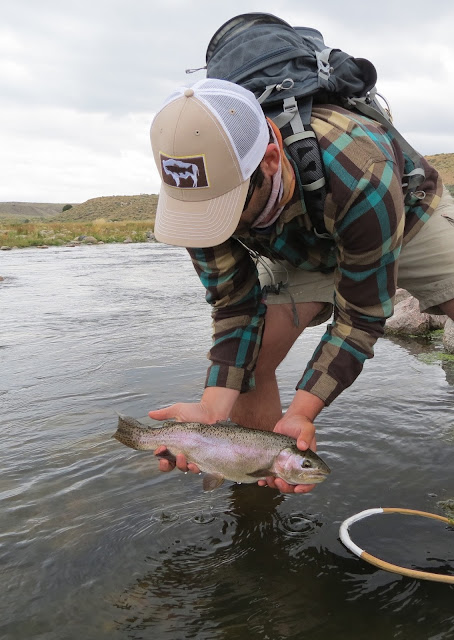Technical dry fly fishing...
Four days into the trip and nymphing was getting lame. We were yearning for some dry fly action and the trout weren't obliging us, or the millions of trico spinners floating down the river every morning. We ended up abandoning the most trout-rich river I'd ever laid eyes on for a chance at something different. We found it at a local meadow, where a portion of tailwater weaves through a ranch supported by plenty of stream side rehabilitation. The tricos were gathering for their last morning on earth and the trout were eagerly awaiting them in the gin clear water below...
We lucked out on the first morning, as the wind was notably absent. This allowed all the spinners to fall hapless on the water. What followed was a feeding frenzy that I never had the opportunity to witness. It started slow at first, like any other trout water easing into a hatch. By the time the spinners death sentence had arrived, a pod of fifty 16-20 inch trout gathered at a long tailout and put their feed bags on. It looked as though the trout gods had placed round boulders across the entirety of the tailout, creating a new riffle. The water was alive, and the rippling of the water was the heads of trout gorging on spinners.
I've fished plenty of trico hatches. I grew up in southeast PA where almost every limestoner has a respectable trico hatch that produces some great fishing. This was on an entirely different level. The amount of trout rising at one time, all huge, blew our minds. I tied on an Al's trico, my preferred imitation from my home and preceded to lay the smack down. However, the trout were no pushovers and only fell for a dead drift in their feeding lane. You'd be surprised that fifty rising trout in such a small space won't move an inch to take a spinner, real or artificial. The presentation and drift had to be perfect and we were able to snag quite a few by positioning ourselves way upstream and casting directly downstream into their lanes. This avoided the swirling effect on the surface created by the vast mats of vegetation below. An eighteen foot leader tapered to 7x was also a key ingredient.
That first morning produced an hour of absolutely amazing dry fly action. On subsequent mornings the wind was so fierce, the bugs never made it on the water, but we still caught them on top. The sight of dozens of noses rising simultaneously, won't be something I'll easily forget, it will be something I'll always remember.
It was insane.
A canyon beckons...

























No comments:
Post a Comment